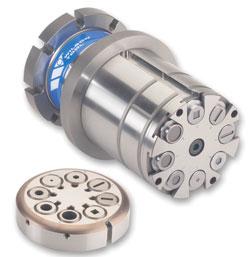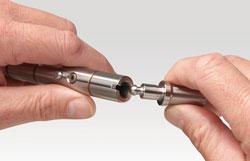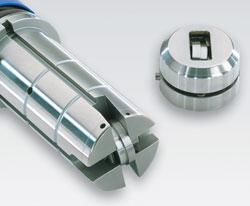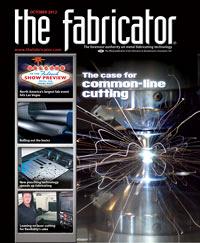Specials Applications Engineer
- FMA
- The Fabricator
- FABTECH
- Canadian Metalworking
Categories
- Additive Manufacturing
- Aluminum Welding
- Arc Welding
- Assembly and Joining
- Automation and Robotics
- Bending and Forming
- Consumables
- Cutting and Weld Prep
- Electric Vehicles
- En Español
- Finishing
- Hydroforming
- Laser Cutting
- Laser Welding
- Machining
- Manufacturing Software
- Materials Handling
- Metals/Materials
- Oxyfuel Cutting
- Plasma Cutting
- Power Tools
- Punching and Other Holemaking
- Roll Forming
- Safety
- Sawing
- Shearing
- Shop Management
- Testing and Measuring
- Tube and Pipe Fabrication
- Tube and Pipe Production
- Waterjet Cutting
Industry Directory
Webcasts
Podcasts
FAB 40
Advertise
Subscribe
Account Login
Search
First to the punch
How fabricators can shorten setup time at the punch press
- By Scott Tacheny
- October 23, 2012
- Article
- Punching and Other Holemaking

Figure 1: Multitools can increase the flexibility of a punch setup and decrease the number of tool changes required.
Producing more parts in less time is the new reality for fabricators looking to get ahead. Today’s high-mix job shops produce less volume per part, but process more jobs, shifting the focus from increasing machine uptime to shortening manufacturing time.
The ability to move from one job to the next quickly is essential to a shop’s ability to produce more parts in less time. Shortening changeover time on the punch press achieves greater efficiency and improves part flow. Proper operator training, optimal tool design (see Figure 1), lean manufacturing practices, and adequate and appropriate tooling inventory all can affect that critical changeover time.
Importance of Good Training
An efficient punching operation requires good operator training. If punches wear prematurely and require frequent sharpening, they may have been improperly set up. Training operators properly ensures consistency of part flow, increases tool life, and improves the quality of the end product.
Make sure that when all operators are setting tool lengths, they measure from the same surface. This seems like common sense, but often the accuracy of this measurement is taken for granted. Many tools have an antibounce plug that’s spring-loaded to ensure the tool doesn’t lift up (or “bounce”) when it shouldn’t during the ram stroke. That spring makes this plug an improper surface to measure tool length. Even so, if workers aren’t trained properly, one operator may measure to the top of the adjusting plug while another may measure to the top of the antibounce plug—a difference of more than 1 mm (see Figure 2).
This can wreak havoc on punching consistency, especially when using form tools. This goes back to punching fundamentals. Each machine has a specific shut height, as well as specific areas in the control to enter information on tool length and other attributes. So if operators don’t account for the machine-specific shut height, minus the length of the full punch and die assembly, minus the material thickness--and they don’t enter the information at the right places in the control--they have a good chance of under- or overstroking the punches. Overstroking can cause a huge amount of sheet marking and over time put a lot of stress on the tools. If an operation uses form tools, understroking with an incorrect stroke length becomes immediately apparent, as the machine produces lazy forms that are severely out of spec.
No matter how efficient changeovers become, shops may not realize any benefit if tools keep wearing prematurely and the machine produces too many bad parts. Operators must change out tooling to meet customer demand--not just in reaction to unexpected, premature tool wear. Proper training is the answer. Simply put, when tools are run consistently from operator to operator, shops will get more reliable results and consistent tool life.
Tooling for Faster Setup
Whether a changeover is required to replace perishables or the complete assembly, assembling or disassembling the guide assembly quickly and easily can shorten changeover time significantly. Small-station assemblies have toolless guide removal, with guide assemblies that pop apart. To shorten setup time on large stations, tool designers use short bolts in the flange, so that operators need perform only a few turns to either loosen or secure the guide assembly during setup.
The ease with which a punch can be removed and replaced also affects changeover time. For years the standard has been toolless and boltless punch retention in small stations, which allows operators to remove the guide and unscrew the punch from the driver. However, a new approach eliminates the need to replace the entire punch by unscrewing it from the headnut or driver assembly. The operator swaps out the punch by giving a key a quarter turn to unlock the punch holder and pulling the punch out (see Figure 3). The operator then pushes the punch into the holder and turns the key again to lock it in place. This eliminates the need to twist out the entire punch, significantly shortening changeover time.
Stripper plate removal and replacement methods also can influence changeover time. Many punch press tooling designs still include a bolt with a ring clip or ring retention system that requires a screwdriver or wrench for removal--a method that lengthens setup. To shorten setup, some small-station assemblies have slide-in stripper retention systems in which the stripper slides out once the punch is disengaged from the assembly. This process simplifies stripper removal and replacement. In large-station assemblies, push-button stripper release systems ease stripper removal and replacement.
Of course, once tooling is assembled, it still needs to be brought to length. If a tool is easier to adjust, it also can shorten changeover time. Various methods enable operators to make adjustments quickly. Most large-station assemblies have push-button adjustments. Some small-station assemblies include toolless adjustment in which operators retract the guide assembly and give the tooling a slight turn. In newer small-station assemblies, tool designers have eliminated both tools and buttons. Instead, punches can be adjusted by grabbing the top of the driver and turning it.

Figure 2: Many punches have an antibounce plug (top on the left view, center on right view) along with an adjustment plug (second from top on the left, middle ring on the right). During setup, all operators should measure tool length from the same surface--the adjustment plug.
Punch Tool Storage Strategy
A dedicated maintenance area or tool cart to house the tools necessary to maintain punch assemblies also can help ensure consistency and ease changeovers. Operators can preload tool carts with tooling dedicated to a specific job. With the right vises, toolholders, wrenches, and lubrication close at hand, operators can change out tooling between jobs quickly and easily.
Some shops may choose to store tools at the point of use, which is a standard lean tactic. But as with many elements of lean, a shop’s approach in the punching area may need to be adjusted for high-mix production. Flexible tooling lies at the heart of punching. A shop can punch blanks on a stamping press all day long, but the operation will never be as flexible as the punch press.
A well-planned punch tooling strategy reflects this. Some shops store all the tools they need in tooling cabinets near the point of use; this method is especially useful if a punch press is in a part-specific manufacturing cell, perhaps with a tool sharpener close at hand.
But what if another punch press needs a certain tool in that cabinet? Does every storage area have a standard maintenance record? How often will personnel need to walk to the sharpening machine? Often it’s more straightforward to dedicate one area to punch tool storage and sharpening. Still, as with so much in manufacturing, the best tool storage approach depends on the application.
Regardless of tool storage strategy, fabricators need to have the tooling ready to go, prestaged at the point of use--already maintained, lubricated, and adjusted--so the operator can spring into action once the punching machine finishes its previous job. This way, the technician can load the program, change out tooling, and be up and running in minutes as opposed to an hour.
Number of Changeovers
A changeover may be fast, but can it be avoided altogether, or at least be less frequent? Could multitools reduce the number of changeovers by increasing turret capacity (see Figure 1)? Such tools can also make a turret punch setup much more flexible. Most tools must be inserted at a certain orientation and can’t be rotated. Newer multitools, though, can change orientation on-the-fly, allowing one tool to punch more part geometries on a nest.
Do frequent changeovers occur because of dull or broken tools that could have been prevented with regular, proactive maintenance? Depending on how often a tool is being used, whether it’s many times in a day or many times an hour, consider choosing tools that use steels that are durable and endure more hits between sharpening.
Operators also should check the punch for signs of misalignment or premature wear. Premature wear may come from improper nibbling practices, causing excessive lateral force on the tool, which decreases die clearance on one side. This can cause rapid wear of both the punch and die. Again, this goes back to proper training.
Also, having adequate or extra inventory of the most popular tooling ensures the punch press won’t be down because a tool needs sharpening. When building a punch tool inventory, fabricators may find that universal punches make life easier. Operators running multiple makes of thick-turret punches can purchase the necessary punch holders with a variety of punches that can be used throughout the shop.
A punch press may use a mix of common tools for various jobs, as well as specialized tools that allow for quick punching of certain parts. Using common tools can minimize the number of changeovers. But common punch tools can also increase the amount of nibbling required, which can slow the operation and shorten tool life.

Figure 3: In this new approach to punch replacement, the operator swaps out the punch by giving a key a quarter turn to unlock the punch holder and pulling the punch out.
Here, certain tools may provide an alternative. For instance, rolling shear tools shear the metal instead of nibbling it (see Figure 4). As another alternative, special-shape tools can reduce the number of hits necessary for each job.
Shortening Manufacturing Time
Careful planning and adequate training go a long way in achieving quick changeovers. By choosing the right tooling for the job, ensuring all operators approach setups and tool maintenance the same way, and implementing lean strategies throughout the process, a shop can complete jobs faster and with greater accuracy.
The goal is to shorten overall manufacturing time. This allows the shop to produce more parts in the same amount of time, increasing shop revenue and shortening ROI for new equipment and tooling.
An operation may use many special tools that punch workpieces in record time, but overall throughput may not increase, simply because the punch press spends so much time waiting for tools to be changed out. Conversely, a fabricator may have few tool changeovers and rely on nibbling, but the punch operation may be slower, tools may need to be sharpened more often, and overall tool life may suffer.
Fabricators tackle this problem by focusing both on the number of changeovers required and the speed of the changeovers themselves. In a high-mix, low-volume environment, excessive changeover time can be a serious drain on productivity.
Say special punch tools shave a significant amount of time for each job. Because they minimize nibbling, the tools last longer and don’t need to be sharpened as frequently. But they do require that the operator change out tools more frequently, which can be a serious burden with excessive setup times.
On the other hand, if the right material and tools are prestaged properly, that changeover time may become so short that it is nearly inconsequential. At the same time, operators can use the best tool for the job, prolong tool life, and improve part quality.
True, more job-specific tools may require a larger punching tool inventory, and this cost must be weighed against any productivity gains. Regardless, in any high-mix, low-volume manufacturing environment, shortening changeover times opens the door to more options, and this includes a fabricator’s approach to tooling on the punch press.
About the Author
Scott Tacheny
12912 Farnham Ave.,
White Bear Lake, MN 55110
800-328-9646
Related Companies
subscribe now

The Fabricator is North America's leading magazine for the metal forming and fabricating industry. The magazine delivers the news, technical articles, and case histories that enable fabricators to do their jobs more efficiently. The Fabricator has served the industry since 1970.
start your free subscription- Stay connected from anywhere

Easily access valuable industry resources now with full access to the digital edition of The Fabricator.

Easily access valuable industry resources now with full access to the digital edition of The Welder.

Easily access valuable industry resources now with full access to the digital edition of The Tube and Pipe Journal.
- Podcasting
- Podcast:
- The Fabricator Podcast
- Published:
- 04/16/2024
- Running Time:
- 63:29
In this episode of The Fabricator Podcast, Caleb Chamberlain, co-founder and CEO of OSH Cut, discusses his company’s...
- Trending Articles
AI, machine learning, and the future of metal fabrication

Employee ownership: The best way to ensure engagement

Steel industry reacts to Nucor’s new weekly published HRC price

Dynamic Metal blossoms with each passing year

Metal fabrication management: A guide for new supervisors

- Industry Events
16th Annual Safety Conference
- April 30 - May 1, 2024
- Elgin,
Pipe and Tube Conference
- May 21 - 22, 2024
- Omaha, NE
World-Class Roll Forming Workshop
- June 5 - 6, 2024
- Louisville, KY
Advanced Laser Application Workshop
- June 25 - 27, 2024
- Novi, MI



























